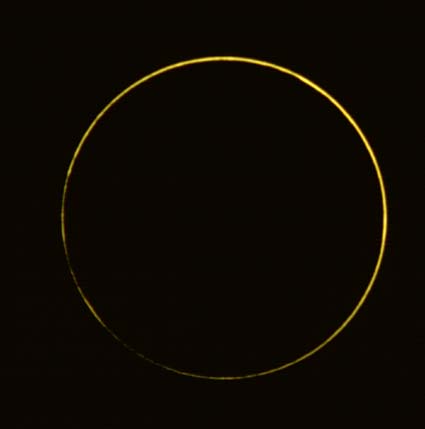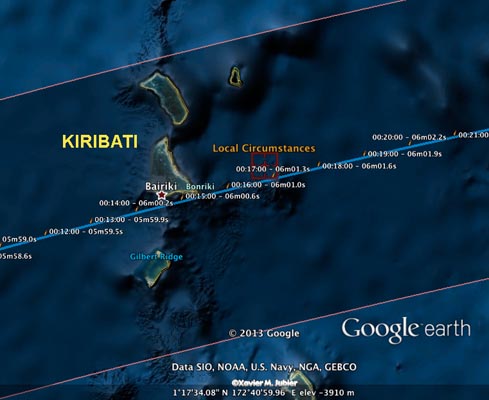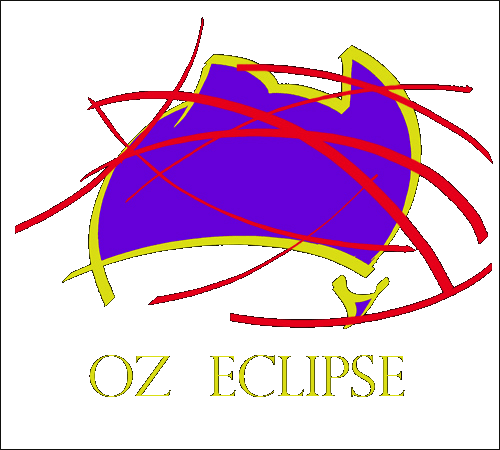 |
|
WAITING FOR THE
SHADOW
SOLAR AND LUNAR
ECLIPSE OBSERVING
HOME PAGE
|
 Eclipses During 2013
Annular Solar Eclipse on May 10 2013
Eclipses During 2013
Annular Solar Eclipse on May 10 2013
On May 10, 2013 a solar eclipse will be visible across Australia, SE
Asia and the south Pacific. The eclipse is visible as an annular
eclipse across a narrow track through northern Australia, SE PNG,
Solomon island and one small atoll on Kiribati.
Illustration at left. Graphic showing the progress of an annular eclipse.
An annular eclipse occurs when the Moon is in the farthest part of its
orbit from earth and the Earth is simultaneously, relatively close to
the Sun. The solar disk is slightly bigger, the lunar disk
smaller and so the Moon doesn’t completely cover the Sun leaving
a bright ring of sunlight surrounding the Moon’s disc. The cone
of deep shade cast by the Moon and known as the umbra terminates well above the
Earth surface. Observers of an annular eclipse stand in an area of lighter shade partly lit
by a thin ring of sunlight. This part shaded area is called the
antumbra.
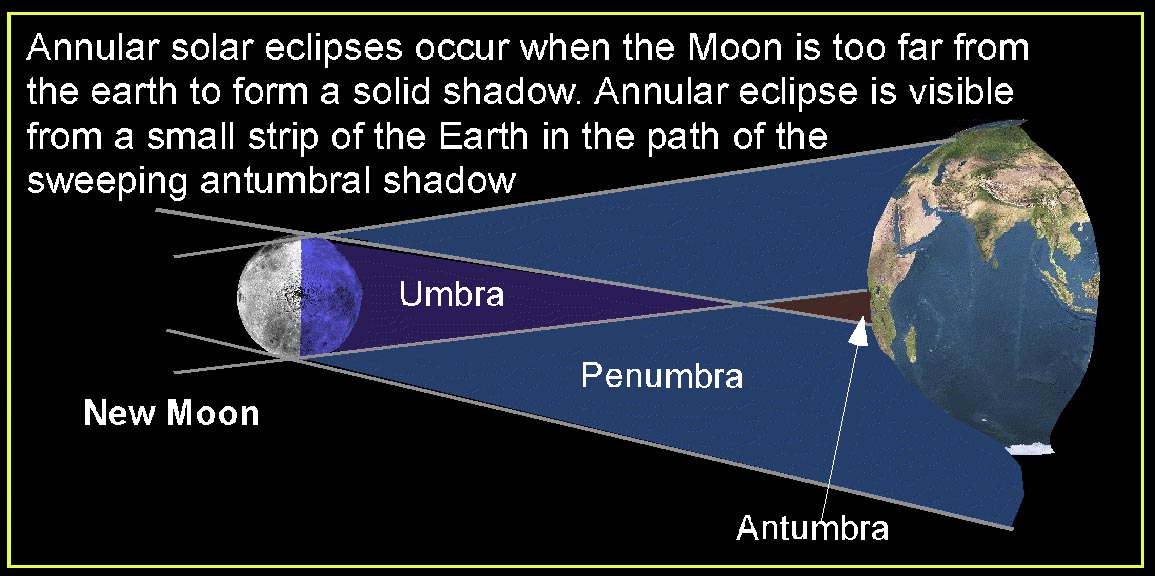 The above diagram shows why the dark umbral shadow does not reach the Earth.
The above diagram shows why the dark umbral shadow does not reach the Earth.
In the antumbra, part of the suns light is always reaching you.
Pictures
from the last annular eclipse visible in Australia on 16 February 1999
from Geraldton, W.A. This annular eclipse won't produce a "ring of
fire" as thin as
the 1999 eclipse which was a 99.2% magnitude eclipse.
This years eclipse is a more
modest 94%. Small points of light known as Baily Beads can be seen around the limb.
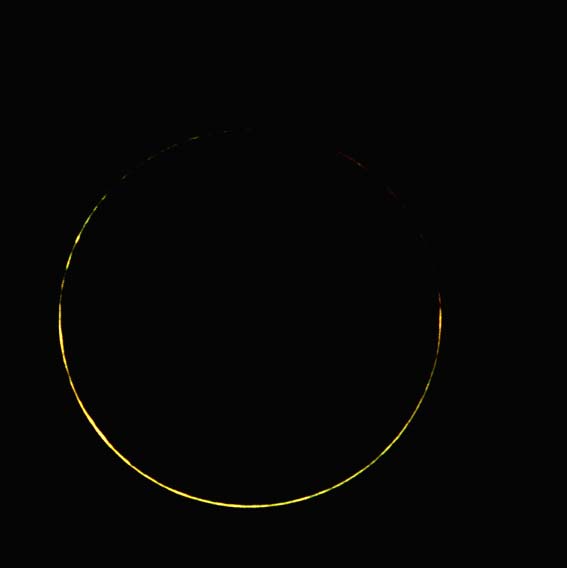 |
Visibility of the Annular Eclipse
- North Australia
- SE Papua New Guinea
- Solomon Islands
- Kiribati
|
 |
Visibility of the associated partial solar eclipse
- All of Australia
- Indonesia
- Papua New Guinea
- Solomon Islands
- Kiribati
- South Pacific Islands
- New Zealand
|
The antumbra first touches down on the Earth surface south of Newman in Western Australia as shown in this NASA animation.
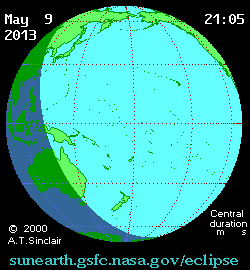
"Eclipse map by Fred Espenak, NASA's GSFC"
The path of annularity
The antumbra first touches down on Earth in an area south west of Newman Western Australia. From the Newman area, you will miss the first half of the eclipse and
the sun will rise at maximum (annular) eclipse. Newman is expensive to fly to and
being a mining area, even a basic motel costs in excess of AUD350 per
night.
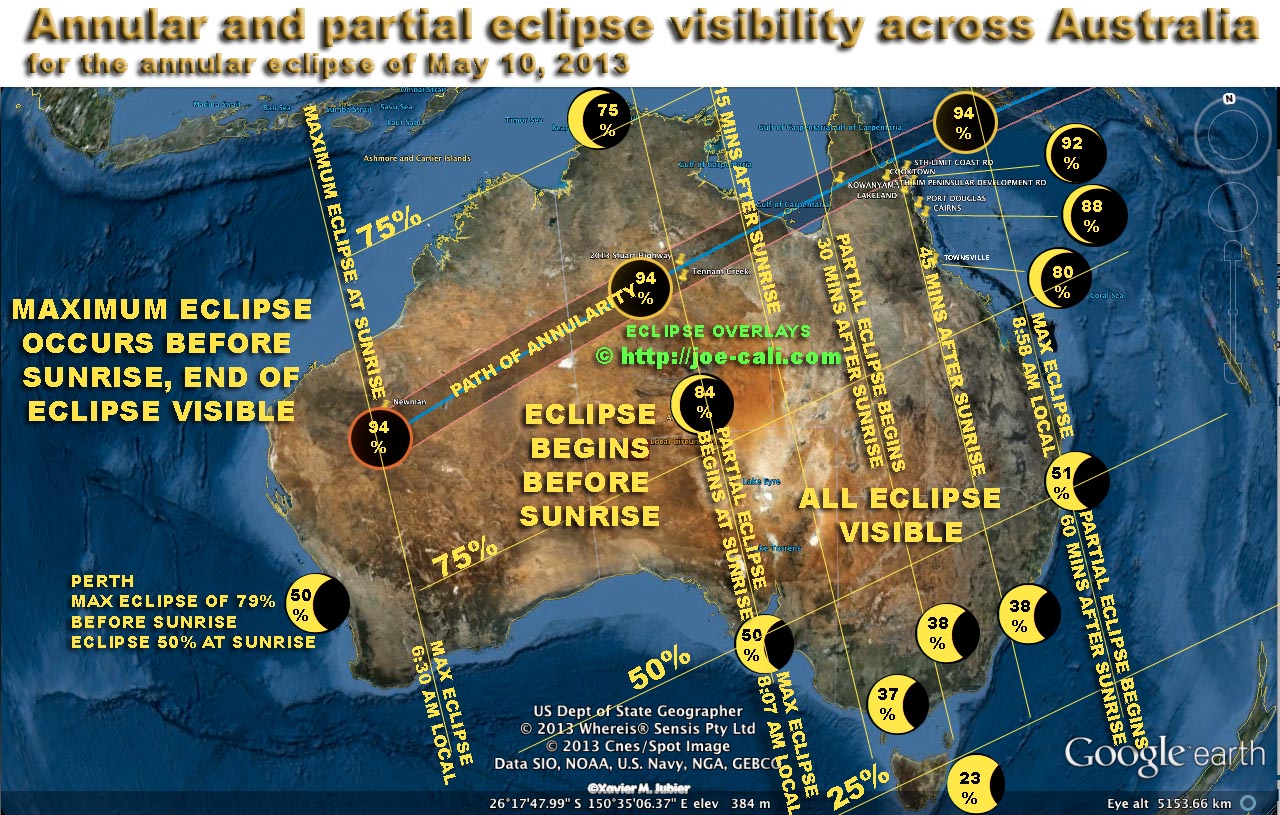
Even if
your particular local circumstances are not listed at the end of this
article, you can read them from this map. The map above shows the
approximate percentages (eclipse magnitudes) across Australia and the
time that the partial eclipse begins relative to your local sunrise.
West of the line from Darwin to Adelaide, the eclipse begins before the
sun rises. West of the line through Newman, the sun rises after maximum
eclipse. For example, geometrically, Perth gets a 79% eclipse but this
occurs before sunrise below the horizon. The sun rises 50% eclipsed
during the last half of the eclipse.
The eclipse rapidly travels ENE 1700km across the Great Sandy Desert
and Tanami Desert. Accessible only from remote desert tracks like the
Canning Stock Route and the Tanami Track, relatively few people will
observe the eclipse from this area.
The next reasonably
accessible observing location is north of the town
of Tennant Creek on the Stuart Highway in the Northern Territory.
Tennant Creek is near the southern limit and the center line crosses
the Sturt Highway about 75-80km north of Tennant Creek. It is possible
to fly there
at considerable expense. The journey from Alice Springs to
Tennant Creek is in a light aircraft and the descent can be very
turbulent. On arrival, no car rental is available so most opt to fly to
Alice Springs hire a car and drive the 500km north to Tennant Creek.
From the Tennant Creek area, first contact, the beginning of the
partial eclipse, occurs at sunrise (6:55 AM local time) and the
annular eclipse occurs with the Sun and Moon perched 16o above the eastern horizon.
The eclipse continues on it’s north eastward journey across the
Gulf of Carpentaria crossing the Cape York coastline at Edward River.
The centreline passes straight through the town of Kowanyama.
Kowanyama is not easily accessible by road but is accessible by a short
and inexpensive commuter flight from Cairns.
The eclipse begins about a half an hour after sunrise at 7:26 AM with the sun 8.5o above the horizon and maximum eclipse occurs at 8:44 AM with the sun 25o above
the horizon. The eclipse crosses Cape York leaving the coast 170km
north of Cooktown. The easiest access to the eclipse path is the
Peninsula Development road north west of Lakeland.
A partial solar eclipse will be visible across all of Australia
No matter where you live in Australia, a partial solar eclipse of
varying magnitude will be is visible. The map above lets you read
off the approximate circumstances for any part of Australia. The map is
plotted relative to local sunrise time. You can get local
sunrise time from local media.
On following pages I have tabulated local circumstances for a number of
towns, cities and locations around Australia and the Pacific Islands.
Alternatively you can use Bill Kramer's eclipse circumstances calculator to work out your exact circumstances
http://eclipse-chasers.com/tseCalculator.php
Pacific Islands
The annular eclipse is visible across the SE of Papua New Guinea and
some of the Solomon Islands. The stable north Australian winter weather
rapidly deteriorates
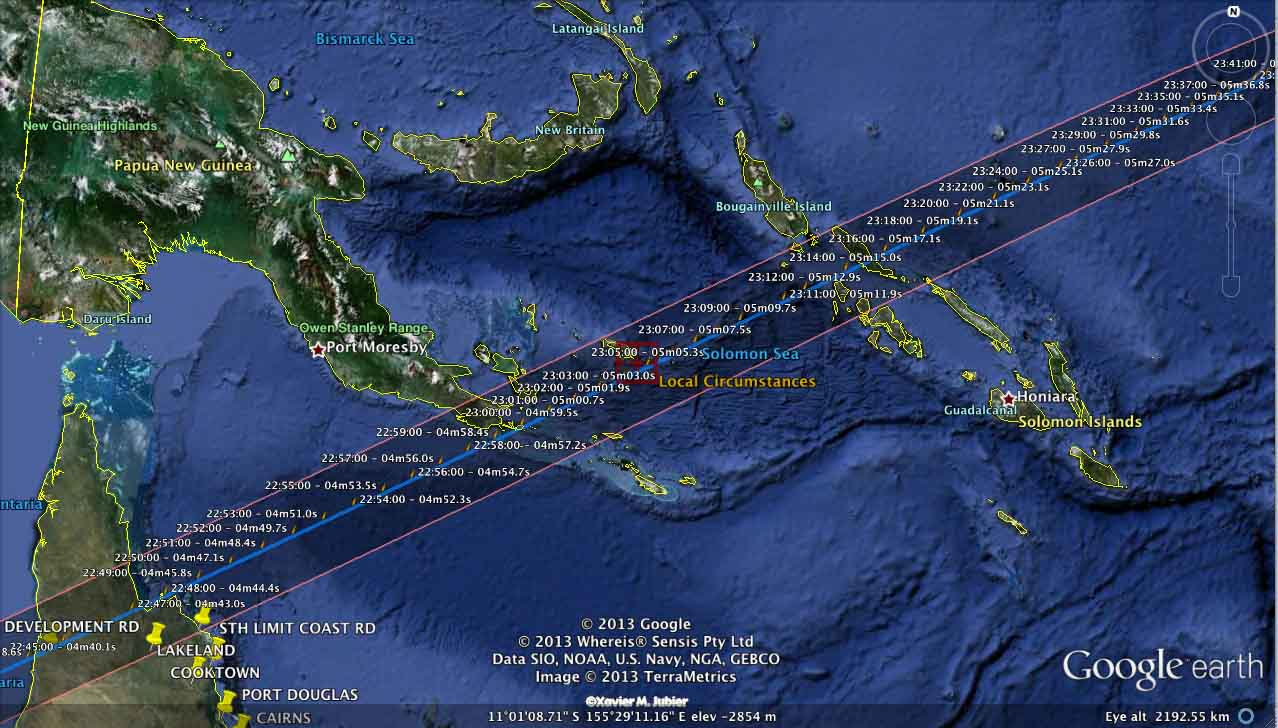
The
map above shows the
path of the annular eclipse across Cape York, Papua New Guinea and the
Solomon Islands. The two numbers printed along the path is the
time of maximum eclipse in universal time and the duration of the
annular eclipse. Courtesy Google Earth and Xavier M. Jubier.
The path of annularity also passes over Kiribati just west of the point of maximum eclipse.
New Zealand
New Zealand lies on the margin of the partial eclipse zone. The most
northern locations only see 15% obscuration while much of the north
island and the west coast of the south island see only a few percent.
EYE SAFETY : How to protect your
eyes during a partial eclipse?
During the partial eclipse and during the annular eclipse, you must use special
techniques to protect your eyes. Looking at the Sun at anytime
during an annular eclipse or even on a normal day can burn the retina
causing permanent eye damage.The Sun is as dangerous to look at during
a partial eclipse as it is on any other day. On a normal day,
if you glance at the Sun or get the Sun in your eyes for example
while you are driving, you don't go blind. But you can't stare
at the Sun for any period of time. During the eclipse, you don't have to protect your
eyes from glancing contact with the Sun any more than you do
on a normal day. The problem is that during the eclipse, there
is a temptation to stare at the eclipse for extended periods
especially as the Sun gets covered. Staring can cause burns on
the retina leading to permanent blind spots.
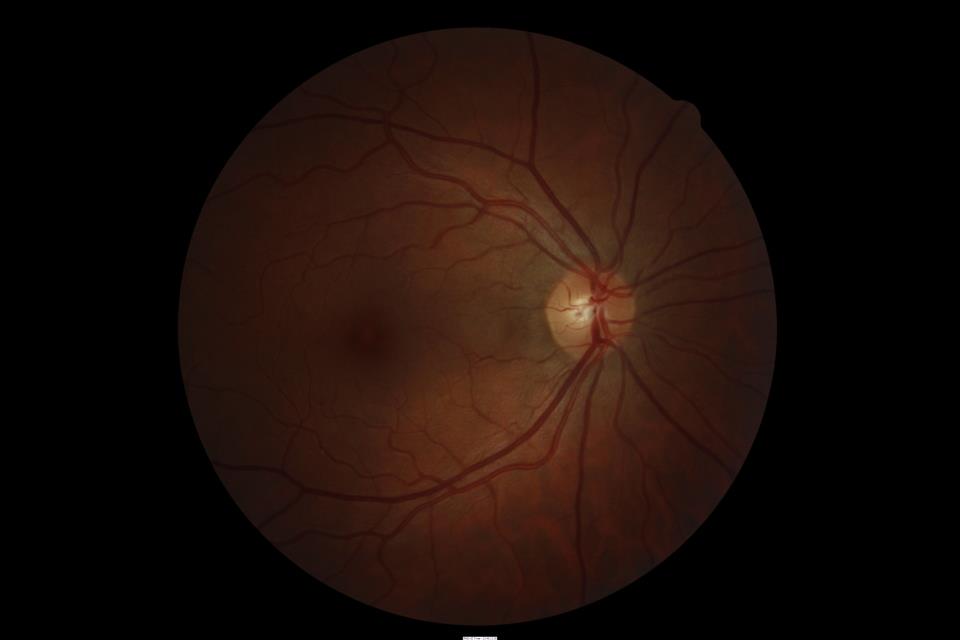
Retinal digital image of a solar eclipse retinal burn. The burn is the dark ring 1/3 of the way in from the left edge.
This person sat in the back of a car in October 1976 as a 10 year old, staring at the progressing partial eclipse as
his unsuspecting family drove to a mountain to watch the total. He has been suffering from a permanent blind spot for the
past 4 decades. This is a recent photo taken at age 45. When he was young, the burn was apparently noticably
crescent shaped but no photos are available from that time. .
Using found materials
from around the home as defacto solar filters is very dangerous.
These materials don't filter the dangerous UV and IR rays and
can lead to blind spots even though the image looks dark enough
to the eye. Examples of unsuitable filters include pinholes,
photographic film negatives, medical x-rays, cd's/DVD's, smoked glass, emergency foil blankets and silvered
confectionary wrappersamong many others. There are no materials
found around the home that will safely filter the Sun's high
intensity light. Some of these materials might look similar to
solar filters but they are definitely NOT safe. The best
policy is to assume that if it hasn't been made for the purpose,
it isn't safe.
Even during the annular eclipse when the Sun is almost completely covered and the ambient
lighting begins to looks like like twilight, the energy in the
very thin crescents and annular ring is more than capable of causing a permanent
burn to the retina.
There are two accepted
safe methods for watching a partial eclipse. One is to look through
some sort of specially made filter material, the other is to
use some sort of projection method.
Filters
Eclipse shades are special cardboard frame sunglasses with properly
made solar filters built-in. These should be available for purchase
at many tourist and retail outlets around Cairns. These are the
most convenient filtration method. Do read the instructions.
Some of these shades are not rated for continuous viewing but
for viewing 30 seconds at a time. A pair of eclipse shades will
probably cost less than $10.00. These cardboard glasses use special
filter materials that effectively cut all wavelengths of light
including the dangerous IR and UV that defacto materials pass
to your eyes. Your eyesight is definitely worth the investment.
Other suitable filters are a number 14 arc welding filter available
from welding suppliers or a special solar filters available from
astronomical suppliers designed to be attached to telescopes
or binoculars.
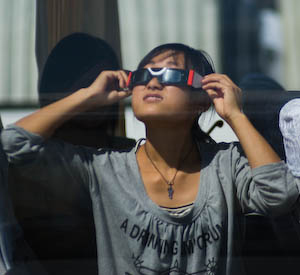 Girl in a bus,
Jinta, Gansu Province, China testing her eclipse shades before
the 2008 eclipse began
Girl in a bus,
Jinta, Gansu Province, China testing her eclipse shades before
the 2008 eclipse began
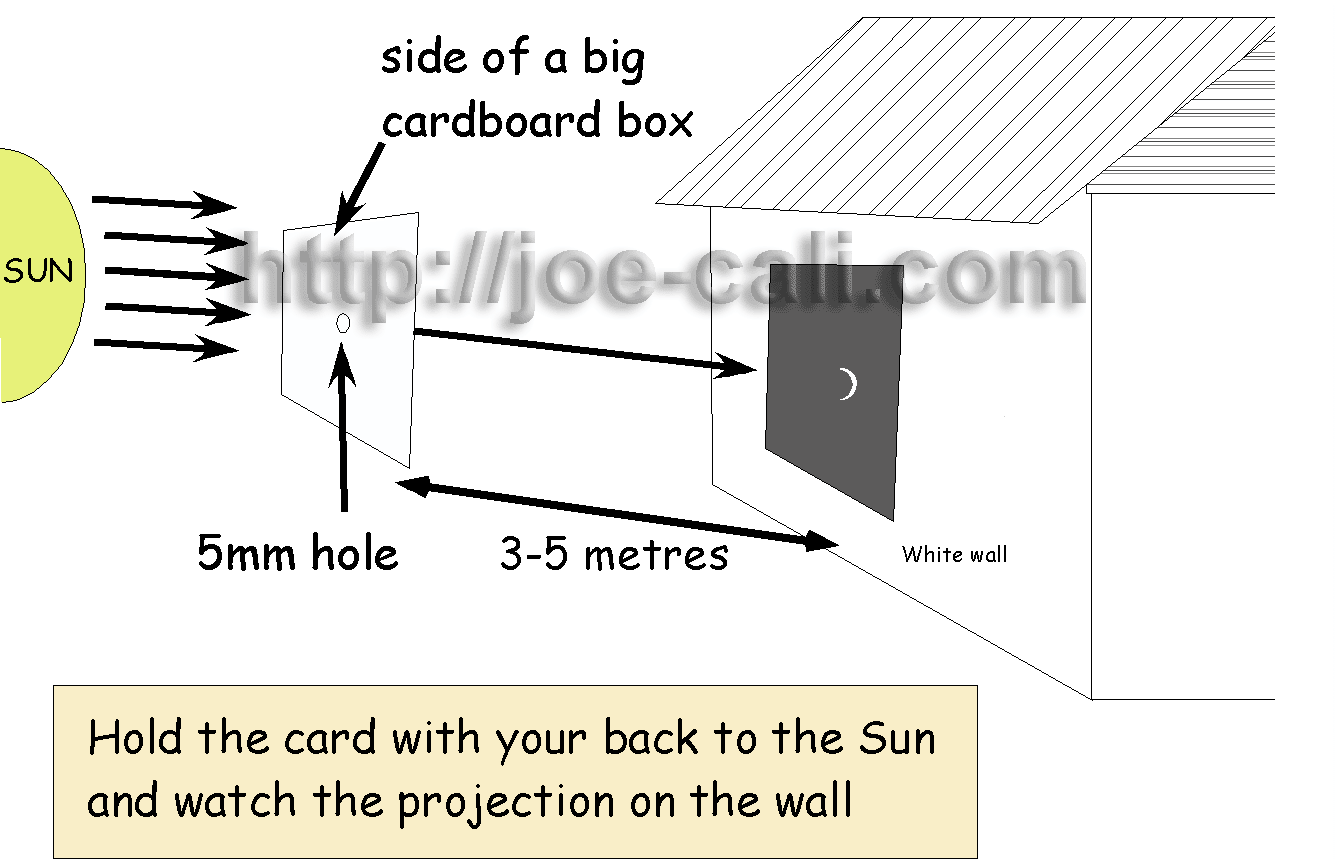
The Sun will be rising
as the eclipse begins. Stand about 3-5m away from the east wall of a white
walled building. With your back to the Sun hold the card up so
that its shadow falls on the wall. In the middle you will see
a small image of the partially eclipsed Sun.
NEXT PAGE => ECLIPSE CIRCUMSTANCES FOR TOWNS AND LOCATIONS AROUND AUSTRALIA



